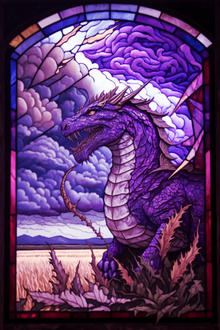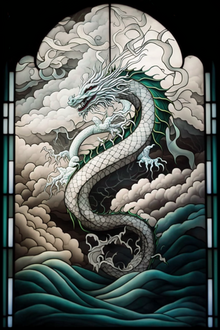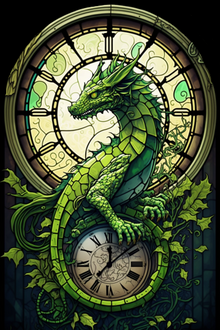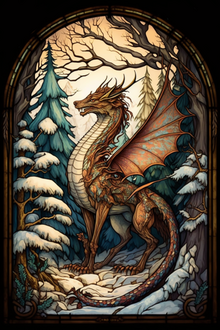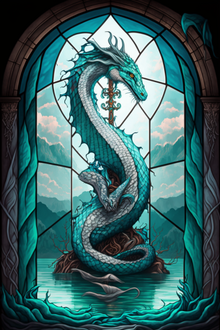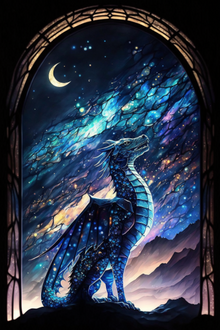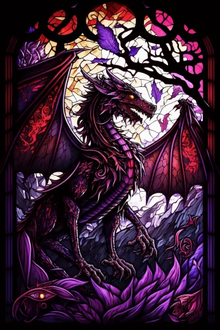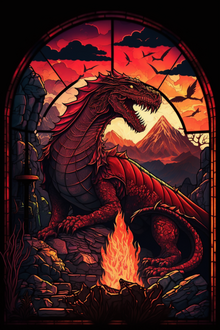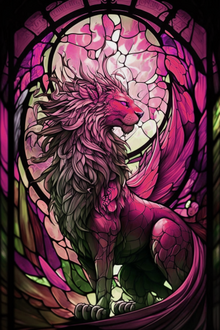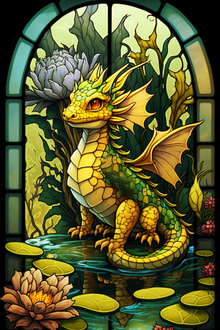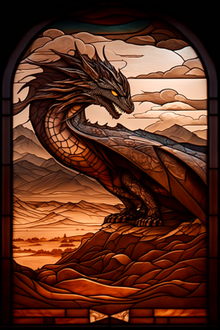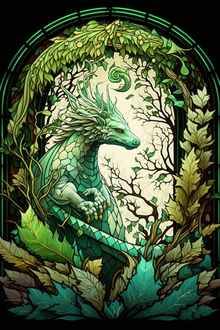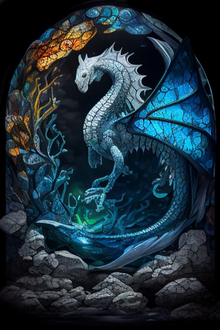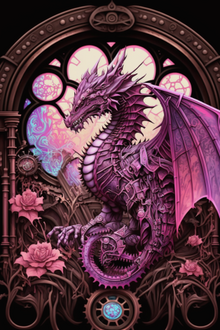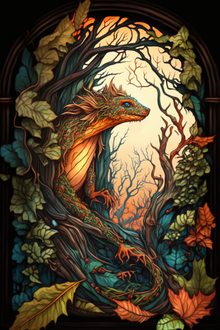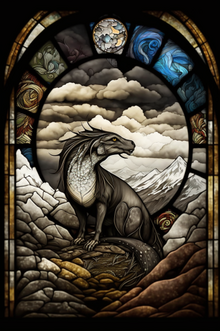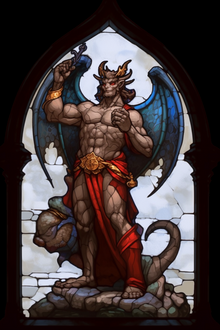|
|
| Line 170: |
Line 170: |
| |[[File:Turkishdragon.png|220px|thumb|left]] | | |[[File:Turkishdragon.png|220px|thumb|left]] |
| | | | | |
| The War Dragons Uthan are unique when looking at other Dragons, because they are not a single Dragon, but rather a triplet of Dragons that are physically identical, but represent brothers and varying aspects of War. These three Dragons are called Aclan the Start of War, Imren the Height of War, and Erdil the End of War. The Uthan Dragons are exclusively worshiped by the [[Savaşinları Ailor]] in their homeland, both as secular rulers, and divine entities. The War Dragons, similar to Severena, have established a form of political control over their followers, but unlike Severena, this extends to political control where the Dragons rule like Emperors over law and order. The War Dragons are also more unique, in the sense that they always appear humanoid and bipedal, even with Draconic features. Due to the Savaşinları people believing Dragons made them (and the Dragons even claiming this), it is generally accepted by draconic scholars that the War Dragons created the Ailor Race, which connects well with their tendency towards war, but took their personal followers south. The War Dragons survived the Denial of Immortality, but became aged and decayed from the event, spurring many of their faithful into the wider world to seek a cure to bring back the glory days of the Brother-Wars between the Dragons. The War Dragons are Occult-exterminating extremists, with their society being entirely Archon, and aimed towards the destruction of Occult, much like Caius. | | The War Dragons Uthan are unique when looking at other Dragons, because they are not a single Dragon, but rather a triplet of Dragons that are physically identical, but represent brothers and varying aspects of War. These three Dragons are called Aclan the Start of War, Imren the Height of War, and Erdil the End of War. The Uthan Dragons are exclusively worshiped by the [[Savaşanlar Ailor]] in their homeland, both as secular rulers, and divine entities. The War Dragons, similar to Severena, have established a form of political control over their followers, but unlike Severena, this extends to political control where the Dragons rule like Emperors over law and order. The War Dragons are also more unique, in the sense that they always appear humanoid and bipedal, even with Draconic features. Due to the Savaşinları people believing Dragons made them (and the Dragons even claiming this), it is generally accepted by draconic scholars that the War Dragons created the Ailor Race, which connects well with their tendency towards war, but took their personal followers south. The War Dragons survived the Denial of Immortality, but became aged and decayed from the event, spurring many of their faithful into the wider world to seek a cure to bring back the glory days of the Brother-Wars between the Dragons. The War Dragons are Occult-exterminating extremists, with their society being entirely Archon, and aimed towards the destruction of Occult, much like Caius. |
| |} | | |} |
| </td><td style="vertical-align: top; width: 50%;"> | | </td><td style="vertical-align: top; width: 50%;"> |
Revision as of 16:28, 15 April 2023
| Dragon Worship |
|---|
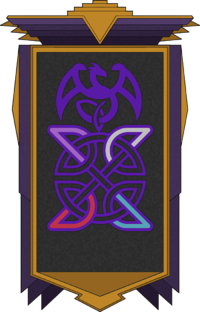 |
| Religion |
|---|
| Pronunciation |
Dragon Worship |
|---|
| Origins |
Unknown, presumed over 7000 years ago |
|---|
| Deities |
|---|
|
Regulus, Yris, Marik, Palatino, Severena, Gaius, Caius, Triton, Aurora, Ballas, Armina, Nox, Zanobi, Laurus, and Wicus. |
| Subsects |
|---|
|
N/A |
Origins
Dragon Worship or Dregodar is commonly believed to be the world’s oldest Religion, one that is uniquely shared by many Races and potentially the most widely worshiped religion across the world, though not the most numerous as it is outnumbered by Estellon and Unionism. Dregodar as a term is often used to refer to Dragon Worshipers, but the term itself comes from western-dominated historical review. After all, the Sihai pre-dated the creation of the Dregodar, and other subsects of Races worshiped Dragons at the same time, perhaps even more numerously than the Elves did. Elven historical telling however dominated the school of historical narration in the west, and as such, this term has become synonymous with it, literally translating to "people of the Dragons". Dragon Worship has undergone some changes over the millennia, and it is generally assumed that what is considered modern Dragon Worship, is nothing like older versions of Dragon Worship, as this religion changes radically with the times and needs of its worshipers. It is unique in the sense that Dragons have worked with and assisted the faithful, but never acted within their own capacity as gods, and occasionally even vocally rejected the idea of of their own divinity. Dragon Worship has more recently exploded back into the public eye, because of relaxing of religious laws, revealing just how pervasive and enduring Dragon Worship actually was, even in the very strongly Unionist Regalian Empire. Finally, it is very important to stress that while evidence exists that implies that Dragons are the true source of creation on Aloria that contradicts the narrative of other Religions, this information is easy to generalize and take out of context, and even the Dragons are quick to say that these things are more nuanced. Dragon worship is not the only ontologically correct Religion, all other Religions are equally as valid, even if Dragon Worshipers can sometimes appeal to a sense of smug superiority in a deeper world understanding.
Core Identity
Dragon Worship is not a traditional Religion with tenets per se, though some of the faithful do find the idea of styling their own life goals, ambitions, and virtues after those of the Dragons. The primary theme of Dragon Worship is preservation of life, or more specifically the cycle of life. To Dragon Worshipers, life itself is the purest expression of spiritual existence, and an act directly ordained by their Gods, the Dragons, who they see as the creators of everything. In the views of Dragon Worshipers, Dragons create life, and are directly responsible for creating all the Races on Aloria, as well as shaping the terrain and circumstances in which these Races live. Their mission for life extends itself as such as a defense against Void Invasions historically speaking, but also the wider issue of Occult mutations and corruptions in creation. To Dragon Worshipers, creation made by Dragons is perfection, and the Occult is a poison that ruins and destroys that perfection and turns creation into abomination. It is important to note that the preservation of life is applied selectively and not whole-sale against any form of death. For example, diseases are "natural" to Aloria, as is the free will used to murder someone, and as such, these forms of death are considered part of the cycle of life, and giving birth to future souls yet unborn. It's important to stress that not all Dragon Worshipers see the duty to life as an ordained mission to stop any and all death, but rather that they selectively decide what types of death are part of the cycle of rebirth, and which ones are corruption, which more often than not tilts against the favor of the Occult. Even with Dragon Worship, there is a great deal of variety between the various Dragon Gods about how to deal with the Occult. The Dragons are roughly divided between a number of Policies concerning the Occult, each with small variations of the same ideas, listed in the God listing below. Unlike other Religions Dragon Worship does not have a traditional concept of Vices and Virtues, though many do style themselves after the enlightened intellect of Dragons as role models. Dragon Worship does have an afterlife, which is the Soul Rivers controlled by Armina.
Worship
Worship among Dragon Worshipers is complicated to pin down, because there is no single adopted method of actively worshiping a Dragon or praying to them. Many Dragon Worshipers perform whatever ritual, custom, or habit that they are personally comfortable with. Some have tapestries depicting the Dragons, others have statues, and others yet only symbolize the dragons on a necklace. Worship can occur in groups or on an individual basis, and there is no real "book" on how to perform worship or how to be a good believer. The only real structure that exists in Dragon Worship, is that each Dragon Throne (a term used to define a Draconic leader and God) has a so-called Matron (which can be any gender) to represent their personal will among the people. These Matrons hold some high position in the faith, but also don't strictly have authority over the faithful, they just communicate the wishes of the Dragons and are as such considered respectable. Any person can become a Dragon Priest, being a Dragon Priest just involves understanding the ideologies and ideals of the Dragons, and being able to fulfill spiritual belief and desire among the faithful in group or individual settings.
Dragon Gods
Lightning Dragon Regulus
|
|
The Lightning Dragon Regulus represents divine justice, leadership, mediation, and compromise. While Dragons all Dragons are roughly equal, the Lightning Dragons are considered the foremost among equals, as they mediate the Draconic Conclave between all other Dragons, preserving a fine balance of authority and function among them. The Lightning Dragon Regulus is the patron of leaders, diplomats, mediators and mentors. He is seen most favorably among the Ailor Race, as the Lightning Dragons often shepherded early pre-Empire Ailor in the Regalian Archipelago from foreign incursions. The domain of the Lightning Dragons is the Regalian Archipelago and surrounding islands. Regulus is the chief architect of the Benign Policy towards the Occult. This policy describes that while the Occult are a stain on the world, because Aloria is a world of the living, their right to life is not abolished merely because of their infection with Occult powers. As a result, Regulus is in favor of letting the Occult live, converting those that are willing to Dragon Magic, but leaving the other peaceful be. Any Occult who cause death or invite more ruinous Magic into the world should be contained however, with violence if necessary. Regulus was reincarnated into Cedromar, a Princeroyal of the Regalian Empire, to read more consult the Imperial Family Page.
|
|
Air Dragon Severena
|
|
The Air Dragon Severena represents meditation, contemplation, mercy, peace and serenity. The Air Dragons are closely linked with the Sihai Race, which they are believed to have created, and continue to shepherd to this day, while their authority extends over much of the Sihai lands and seas beyond. Instead of perishing like many other Dragons during the Denial of Immortality, an event in which the Dragons collectively decided the best way to defeat the Arken was rob them of their immortality, Severena and the other Air Dragons entered an eternal slumber that froze the seas around the Sihai homelands, turning it all into Jade, and creating the Jade Sea and the Jade wall which to this day is used to defend against the massive Demon monstrosities that lay siege to the Sihai lands. Severena is the architect of the Enlightened Policy towards the Occult. This policy describes that while the Occult are a stain on the world, to inflict violence and suffering where there is none, is a form of karmic self-harm that poisons the souls of the faithful. As a result, Severena's policy towards the Occult is one of only striking when the faithful or the clean are struck in turn, and to never draw blades first on those who have suffered the infection of the other Dimensions. Severena still slumbers in the Sihai lands, communicating with her faithful through their dreams.
|
|
Time Dragon Palatino
|
|
The Time Dragon Palatino is primarily an agent and guardian of the continuation of time, but in some part also represents the need of life to continue, to move on, and to not stand still in grief or contemplation for too long. Palatino's authority extends over Ellador and the surrounding islands only. Palatino never interacted much with mortals, as his stewardship of time and ensuring it follows a linear trajectory absorbed nearly all of his effort, though there are some tales of Dwarves having earned his favors, creating the legendary Caverns of Time, where Dwarves could mine for resources as time passed inside the caves where it stood still outside. These caves have been lost to time, though Palatino is still somewhat favorably looked upon by the Dwarves, save for a short stint of their mistrust towards dragons during the Dregodar-Dwarven Wars. Palatino is the chief architect of the Apathy Policy, marking his and his faithful's indifference to the Occult as he and they simply do not have time to pay attention to them. It is generally well understood by all Dragons and the faithful, that if time itself falls into the hands of the Void and Exist, that life is completely done for in Aloria. As such, Palatino made a bargain with a number of unknown Ordial Entities to keep him safe in The Beyond, despite the open hostility of some Ordial entities towards Dragons. The reasoning was that the Ordial entities would also not benefit from time itself stopping or reversing in Aloria, and as such there is a mutual interest to keep Palatino safe in The Beyond.
|
|
Change Dragon Valerius
|
|
The Change Dragon Valerius is primarily an agent of the seasons but also in an allegorical sense represents the intangible concept of change itself as something turns into something else entirely. Their authority is over the North Belt with Jorrhildr in particular being their homeland. They also represent the more tangible aspects of fertility and childbirth as well as lineage. It was incredibly unclear for a very long time whether Valerius was ever real, since they were never seen by any mortal's eyes, though in recent centuries more and more Urlan indicate that after Symbiosis, the memories of the Oorl showcase the same stag-like Dragon showing up over and over, indicating that Valerius showed favor to the Oorl worms. By extension, the Urlan would soon follow after, with Valerius appearing to the Urlan in Jorrhildr to guide their efforts to increase their numbers. Valerius is not known as a Dragon creator but one who changes the creations of other Dragons to their own design. Valerius is the chief architect of the Strangled Policy. Valerius is not overtly hostile to the Occult, and in fact believes they should all get to live their lives out in peace, even the violent ones, but that Dragons share a responsibility to change creation and mortals so their bodies can no longer host the Occult infection, so the threat of it will die out. Valerius still roams somewhere in the frozen wastes of Jorrhildr, protected by the violent Urlan tribes.
|
|
Mind Dragon Nox
|
|
The Mind Dragon Nox represents wisdom and foresight, but in general is also supposedly the agent of creating free will and the independent thought of mortals, thus allowing mortals to think. Nox is a punished Dragon by the other Dragons, because he violated the laws of creation, creating true shapeshifters namely the Slizzar. Much of his authority was stripped and confined to Sassrakkand only, as shapeshifting means were forbidden among Dragons for creation. In their enlightened judgement however, the other Dragons could not bring themselves to kill the Slizzar, and so they were allowed to live. Where Nox lost authority over the world, he gained it by sending his Slizzar out in the world and establishing influence over the various areas where other Dragons nominally held sway. Nox split his soul into six parts and created the Anandriya Slizzar during the Denial of Immortality. There is still ongoing debate among Dragons whether to revive Nox or leave his soul divided. Nox is the chief architect of the Unheeded Policy. He and his followers truly do not care about the Occult Infection, and leave much of the decisions and clean-up to other Dragons and Archon while they mind their own business.
|
|
Star Dragon Aurora
|
|
The Star Dragon Aurora represents creation both in the material and the sentient sense. She is a brilliant creator of physical objects and seen as a patron of craftsmen, but also the chief creator of uncivilized races and animal species, thus in turn also being the mother of all animals. Aurora's domain was once Teled Methen and the Sundered Lands, but during the last millennia of the Allorn Empire, she fled with the Dragon-worshiping Teledden to Ellador due to religious prosecution, abandoning her Crater of Creation. In Ellador, she was supposedly killed by the Dwarves, creating the Undead Frost Dragon Frisit. This was later discovered to be a ruse however, as an Ordial Entity inhabited her corpse and lied to the Isldar, turning them into a puppet murder cult. When Aurora was brought back to life by the other Dragons, a civil war erupted among the Isldar, with one side joining forces with the Ordial Entity known as the Glacial, and the others with Aurora. A fragile truce remains, having given Aurora enough time to create a new Crater of Creation somewhere in Ellador, thus technically trespassing on Palatino's domain. Aurora is a supporter of Palatino's Apathy Policy, because she considers her work to carefully balance the world's ecosystems of animals to be far more important than the Occult struggle.
|
|
Heart Dragon Triton
|
|
The Heart Dragon Triton, sometimes also referred to as Ruin or Ifrit, is the representative of emotions, passion, action and willpower. Triton supposedly made the hearts of mortals to allow them to feel things, but also has burning passions and desires for action and conflict. Triton's domain is Sendrass, though he has been absent from the world for over 70,000 years. During the early Void Invasion, Triton, Yris, Caius and Marik fought the Demonic scourge. After centuries of losing battles, Triton and Yris chose to charge into the Void and Exist respectively, but becoming trapped there in the process. Triton eventually clawed his way to enough power to become the Void God Ifrit the Darkscale. He is as such both Dragon and Void God at once, though his Void God interpretation varies wildly from his Draconic interpretation. Triton is the chief architect of the Control Policy. The Control Policy is one step below the Extermination Policy, in that it despises the Occult, but believes that the Occult can be allowed to live if they are completely subservient and obedient to the will of the Draconic. Triton is a unique entity in the world, in that he is the only entity with uninterrupted consciousness from the beginning of time, while other Dragons have perished and forgotten their memories, or other Gods are too young to have existed for all this time. Triton's consciousness is uninterrupted from the time of the Seraph, and perhaps the only living entity that can give first hand accounts of those days, or the genesis of Dragons.
|
|
Fire Dragon Caius
|
|
The Fire Dragon Caius represents destruction, annihilation, struggle, conflict and rage. It is said that the urge to struggle and compete between mortals is from his desires to see life tested against itself and to find ever greater champions and stronger survivors. Caius rules over Guldar or the Maquixtl homeland as it is now, once having been the homeland of the Avarr and Eronidas subsequently, whom he favored but fell out of favor eventually. Caius is a patron of generals and admirals, as he is often seen as the foremost commander among the soldiers Dragons Marik, Yris and Triton. Caius is also seen as the supreme commander of the Ley construct armies, armies of stone entities that were used during the many millennia to fight the Demons, but which have all become inert since the fall of the Allorn Empire. Caius is the chief architect of the Extermination Policy towards the Occult. This Policy bears very little explanation, Caius and his supporters simply want all the Occult to die, and for all Occult infection in the world to be burned out like the plague it is. Caius's followers tend to be the most nuclear of all Dragon Worshipers, who are sometimes even reviled among the other faithful for their fanaticism.
|
|
Soul Dragon Armina
|
|
The Soul Dragon Armina represents the creation of the intangible soul, she is both the guardian and steward of the Soul Rivers and the Draconic afterlife, but also responsible for the seeding of new souls in every birth on Aloria. Armina was adopted as a favored entity by the Suvial, as even though her domain in the Suvial Firelands was once uninhabited, their arrival forced a somewhat unique cooperation between Armina and Avinla to protect life, finding common goals and ideologies even among opposing forces. Armina helped Avinla fuel the Firescars with Dragon Magic, but mysteriously disappeared into the Soul Rivers around the Denial of Immortality from which she has not yet been found. Avinla is a supporter of Triton's Control Policy, in which she supports the idea that the Occult can exist on Aloria, but only while tightly controlled and managed by the Draconic forces so as to ensure their compliance. There is some debate about whether Armina's disappearance is concerning for the Draconic afterlife, though nobody has ever come back from the afterlife to say whether or not the gates are closed.
|
|
Magic Dragon Zanobi
|
|
The Water Dragon Zanobi is perhaps comically the strongest of all Dragons and also the smallest being no larger than a domestic cat, as she is the creator and manager of Dragon Magic itself, the source of power for all Dragons and all Archon and Dragon Magic users, lending her power to all others. Zanobi represents joy, playfulness, youth, energy and kindness. Her authority extends over Hadar except for Sassrakkand and its surrounding lands. Zanobi did not interact much with mortals until the arrival of the Allar led to her close involvement with their adjustment to Hadar after fleeing Sendrass, to such a point that the Yellow Water Dragons became a fixture in Allar culture. The Water Dragons tragically perished after a long fight against a mysterious magical illness that the whole of the Allar Race tried to move heaven and earth to cure. Much to their horror however, their efforts were in vain, leaving their Race collectively traumatized because of their inability to save the Dragons. Recently, Zanobi and the Dragons were revived, and are working to fight the Void corruption in Sendrass. There has been some implication that Zanobi and the Water Dragons were poisoned by Nox and the Anindriya, because Zanobi has traditionally been seen as Nox's jailor, controlling the land around Sassrakkand, though none of this was ever proven. Zanobi is the chief architect of the Conversion Policy, one that expresses genuine support and love for the Occult, but wishes for them to convert to Dragon and Primal Magic to cleanse their infection.
|
|
Sand Dragon Marik
|
|
The Sand Dragon Marik represents courage, bravery, strength and will for battle. He is also strongly associated with the Sun and the Moon, objects which he supposedly controls in the night sky. Marik is traditionally seen as the most soldier-like of all Dragons, always the first in the fray, first on the frontlines of the war against the Occult Infection, along with the other Bronze Dragons. Marik and the other Bronze Dragons perished during the Great Storm, an event which was later discovered to have been hijacked by Ordial Entities using the fear and doubt of Dragons to cause the death of the Sariyd civilization. Marik and the Bronze Dragons however splintered their souls, giving birth to the first Songaskians, and harboring the power of their souls into their souls, thus creating the closest thing to mortal Dragonkin in Aloria. It is said among the Songaskians that Marik's consciousness transcended to the Sun, where it remains to this day, this also being the reason why the sun is so symbolic for Marik and Songaskians in general. Marik is a supporter of Triton's Control Policy, which is already working to a high degree in Songaskian society where many Mages function according to the designs of Dragon Dogma and Marik's will. The revival of Marik is an ongoing topic of debate in the Draconic aligned, with some speculating it would require all Songaskians to merge their consciousness to rebirth his soul.
|
|
Nature Dragon Ballas
|
|
The Nature Dragon Ballas represents innocence, naivety, love, forgiveness, and purity. Ballas out of all Dragons is considered the kindest and most good-willed, responsible for the creation of all plant, flower, and tree species on the world, and working with Aurora to create flora and fauna in natural harmony. Ballas's authority is the larger Daen continent and Fendarfelle, save Teled Methen and the Sundered Lands. Ballas lived alongside the Allorn Empire for thousands of years without getting involved. At some point however, the Elves turned on the Dragons. While Aurora fled north, it is said that Ballas and the Green Dragons just let themselves get killed by the Elves, though modern revisionism has created some doubt to the idea that the Elves were even capable of killing Dragons, and that they just faked their own deaths. Ballas supports Zanobi's Conversion Policy, believing from the goodness of his nature that the Occult do not deserve to be prosecuted or killed, but that they should express at least the minimum concession to cleanse themselves.
|
|
Space Dragon Yris
|
|
The Space Dragon Yris is somewhat deceptively named, not representing the space outside of Aloria and the stars and the cosmos, but rather the tangible and intangible space between objects and people on Aloria. She represents the distance and physicality of objects in relation to each other. More tangibly speaking, Yris controls the Ley network, a superimposed reality of Aloria which has a vast network of magical highways spanning the world, with nodes and Dragon sites in between. Yris is also chiefly responsible for the creation and maintenance of all Soul Cores, even the ones held in Junctions belonging to the authorities of other Dragons, and for the creation of Leystone the very stone-like metal which most Dragontech is made out of, thus becoming a patron of engineers and technicians. Yris's authority is over Southwynd and Westwynd, but notably the oceans around it, as she was a deep-sea Dragon who waged war against the Occult on the deepest bottoms of the oceans. Yris disappeared over 70,000 years ago when she charged into the Exist to take the fight directly to them. It is unknown what happened to her there, as unlike Triton who became a Void God, all signals from Yris ceased, and have been silent for the past 70,000 years, with no Exist entity ever referring to her existence. It is presumed that Yris supported Caius's Extermination Policy, though this cannot be stated for certain.
|
|
Metal Dragon Gaius
|
|
The Metal Dragon Gaius represents the spark of life that gives life to inanimate objects, as well as the minerals, metals, gems and other resources found in the world of Aloria itself. Gaius is shrouded in mystery, because although he had a favored Race, the Bralona, they supposedly killed him and the other Rose Metal Dragons. His isolated authority was over Farsouth and the small island of Barratt in the North Belt, where he experimented with artificial life. While other Dragons created organic creations, Gaius experimented with the creation of inorganic entities, but denied his creation the ability to self reproduce like all other creations could. His creations eventually rebelled against him, causing him to disappear. Gaius has not yet been found, and even the Bralona aren't quite sure what happened to him, as their memories from several thousands years ago when he disappeared have been altered or become murky. Gaius still represents an ambition among technicians however: creating truly sentient and self-replicating self-aware life, the spark that makes Dragons divine. His policy towards the Occult is unknown, though many speculate that it aligned with Valerius's Strangled Policy.
|
|
Decay Dragon Wicus
|
|
The Decay Dragon Wicus represents the timely arrival of death, the decay of time, and the dismal disease and miasma of the world. Wicus is not an often worshiped Dragon on account of his creation of plagues and diseases that kill thousands. He once favored several now extinct Races on the land now inhabited by the Kathar, where the locals developed a strong ideological understanding of the need for death, disease, and decay. Wicus's magic was hijacked by the Kathar to produce the Dulofall Mildew, but then used far beyond the scope of his wishes, shocking him to horror. Wicus fled the Dread Empire's landmass following the Kathar arrival and extermination of the local Races, to the island of Solangeria where he continued to experiment with diseases on the unkillable Temple Orphans, the perfect test subjects. It is presumed Wicus was killed by the Temple Orphans, who cut him to a thousand pieces and created the Noxious Lagoon on the island, which is entirely covered in diseases orange plants. Despite his somewhat unpleasant representation, Wicus is held in high esteem among doctors and herbalists, as he represents the ultimate understanding of the organic body and function. His attitude to the Occult aligned with Zanobi's Conversion Policy, though was less concerned about conversion per se. In his eyes, the Occult were like a disease, no more dangerous than any of the pandemics he created, and as such he wasn't very alarmed about them in general.
|
|
Earth Dragon Laurus
|
|
The Dragon Laurus represents stubbornness, endurance, perseverance, decisiveness, and longevity. Laurus is sometimes also referred to as the Earthshaper, as the Gray Earth Dragons were responsible for shaping the land and the mountains and the geography of Aloria. Laurus's authority was over that of Oldtera, notably Ceardia being his homeland. Laurus perished in the destruction of Ceardia through unknown means, though given the insane destructive forces that ripped apart Ceardia, it has always been assumed that his Magic was somehow corrupted or hijacked by some other force. This has always been speculated to have been Void forces, as it coincided with a massive break-out of Void Demons on the continent, but Ordial involvement has not been ruled out. Laurus was a supporter of Palatino's Apathy Policy, because he was far too busy creating the landscape of the world, and continually re-shaping it to fit the needs of the other Dragons. Laurus and the Gray Dragons were revived and are currently busy attempting to terraform Ceardia back to an inhabitable state. Laurus is the patron god of defenders and protectors among the Dragon Faithful, and also showed particular favor towards Old Gods and other Pagan believing Ailor, even though he terrorized them with earthquakes when they still lived on Ceardia.
|
|
War Dragons Uthan
|
|
The War Dragons Uthan are unique when looking at other Dragons, because they are not a single Dragon, but rather a triplet of Dragons that are physically identical, but represent brothers and varying aspects of War. These three Dragons are called Aclan the Start of War, Imren the Height of War, and Erdil the End of War. The Uthan Dragons are exclusively worshiped by the Savaşanlar Ailor in their homeland, both as secular rulers, and divine entities. The War Dragons, similar to Severena, have established a form of political control over their followers, but unlike Severena, this extends to political control where the Dragons rule like Emperors over law and order. The War Dragons are also more unique, in the sense that they always appear humanoid and bipedal, even with Draconic features. Due to the Savaşinları people believing Dragons made them (and the Dragons even claiming this), it is generally accepted by draconic scholars that the War Dragons created the Ailor Race, which connects well with their tendency towards war, but took their personal followers south. The War Dragons survived the Denial of Immortality, but became aged and decayed from the event, spurring many of their faithful into the wider world to seek a cure to bring back the glory days of the Brother-Wars between the Dragons. The War Dragons are Occult-exterminating extremists, with their society being entirely Archon, and aimed towards the destruction of Occult, much like Caius.
|
|
|
Trivia
- Dragon Worshipers can change their preferred Dragon Throne, but tend to generally stick with one for their entire lives. Changing a Throne is not seen as something shameful, but continually doing it over and over is. It is also considered shameful if it is done on a whim, as opposed to a major life event.
- It is sometimes believed that Dragon Worship is compatible with Emended Unionism because Regulus being Cedromar is also a God in that pantheon, however this is not the case. Emended Unionism has some views about the Occult that are incompatible with Dragon Worship, and also generally prescribes to a more dogmatic life than Dragon Worshipers would tolerate. There may however be friendly relations between the two religions, which can be seen in Anglia where Regulus worshiping Isldar and Ailor live side by side with Emended Ailor.
- Infantilization or imitation of Dragons where not part of racial Abilities is considered taboo among the Dragon Worshipers. Imitation through mutations of Draconic features however is considered flattery. Dragons are however immensely offended, if their worshipers keep mini-dragon-like creatures as pets. Any religion would find this grossly offensive.

